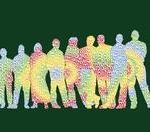Hannah’s Hair – Why Traits Matter
 It’s an unacknowledged law of nature that whatever the texture of a girl’s hair, she wants the opposite.
It’s an unacknowledged law of nature that whatever the texture of a girl’s hair, she wants the opposite.
For years I wrapped my tangles around soup cans and around my head, squished it under irons, and subjected it to stinky straighteners. I’d often succeed, only to venture outside and have the hated curls spring anew.
Eleven-year-old Hannah Sames also relaxes her curls. In fact, the pale kinks were the first thing Hannah’s parents, Lori and Matt, noticed when she was born. “Their other daughters, Madison, five, and Reagan, two, had stick-straight hair, as do Lori and Matt. When the birthing goop had dried, Hannah’s curls were odder still, weirdly dull, like the ‘before’ photograph in an ad for a hair conditioner,” I wrote in my gene therapy book. A more recent story about a little girl with curly hair but straight-haired siblings and parents in the Times of India is remarkably similar.
 The photo to the right of Hannah and her dog Ginger is on the cover of my human genetics textbook, to show a striking variant of an inherited trait, hair texture. My best friend Wendy Josephs took that photo and others in this post on an early spring day in 2011, when we visited Hannah and her sisters. Those photos were the last taken before Hannah began the quest to straighten her hair. It turns out that the unusual kinky hair is an important clue to identifying a very rare neurological disease.
The photo to the right of Hannah and her dog Ginger is on the cover of my human genetics textbook, to show a striking variant of an inherited trait, hair texture. My best friend Wendy Josephs took that photo and others in this post on an early spring day in 2011, when we visited Hannah and her sisters. Those photos were the last taken before Hannah began the quest to straighten her hair. It turns out that the unusual kinky hair is an important clue to identifying a very rare neurological disease.
DISCOVERING AND DESCRIBING GAN
Hannah has giant axonal neuropathy – GAN. It’s like amyotrophic lateral sclerosis (Lou Gehrig’s disease) in a child, a gradual failure of motor neurons to stimulate muscles and eventually failure of sensory neurons too. Swollen intermediate filaments (IFs) stuff the axons in what one researcher terms a “logjam.” Whole-body effects are slow yet profound, and ultimately overwhelming. I’ve covered Hannah’s story here, beginning with “A Little Girl With Giant Axons, A Deranged Cytoskeleton, and Gene Therapy,” and most recently the wonderful news that a gene therapy clinical trial is finally underway.
 Thanks largely to the herculean efforts of the Sames family, the first child received an infusion of working gigaxonin genes into her spinal cord at the NIH Clinical Center on May 27. But it isn’t Hannah. She can’t participate until the researchers figure out a way to dampen a potential immune response. Hannah’s two mutations are full deletions, and so if the missing protein suddenly shows up, her immune system could go into overdrive.
Thanks largely to the herculean efforts of the Sames family, the first child received an infusion of working gigaxonin genes into her spinal cord at the NIH Clinical Center on May 27. But it isn’t Hannah. She can’t participate until the researchers figure out a way to dampen a potential immune response. Hannah’s two mutations are full deletions, and so if the missing protein suddenly shows up, her immune system could go into overdrive.
An important clue in Hannah’s diagnostic odyssey wasn’t a genetic test, an exome or genome sequence, or a scan. It was her hair. Hannah’s aunt showed a video of her niece to a friend who worked with children who have muscular dystrophy. The friend urged the family to take Hannah to a pediatric neurologist, and when they did, he stared at her hair and went to his bookshelf. “He took out a huge textbook and showed us a photo of a skinny little boy with kinky hair, a high forehead, and braces that went just below the knee – he looked exactly like Hannah. And he had GAN,” Lori said.

THE HISTORY OF HAIR IN GAN
In 1971, researchers at the University of California, San Francisco discovered the giant axons and named the disease, noting the extreme curls. Their subject was a six-year-old girl whose neurological decline was just like Hannah’s.
In 1974, another case appeared in the medical literature. Those researchers urged doctors to suspect GAN “in a patient with tightly curly, pale scalp hair, unlike that of his parents.”
By 1987, only twenty more cases had been reported. The numbers grew, slowly, until by 2000 enough cases were known to finally search for mutations in common. That led to chromosome 16 and the gene that encodes the protein gigaxonin, which regulates the degradation of IFs in a variety of cell types. Part of the cytoskeleton, IFs are actually more abundant than the microtubules and microfilaments that get all the attention in textbooks. In GAN, missing or abnormal gigaxonin most obviously disrupts the neurons’ IFs — aka neurofilaments — but also alters how keratin IFs form in hair.
GAN, like many single-gene diseases, is “pleiotropic” – it has several signs and symptoms. When patients present with different subsets of the manifestations, a single disease can appear to be several. One version of cystic fibrosis, for example, causes only male infertility; another causes only sinusitis and bronchitis. So some kids with GAN don’t have the kinky hair. But for many, the trait is very helpful in distinguishing GAN from Charcot-Marie-Tooth disease and other “polyneuropathies.”
 NOT SEEING THE FOREST FOR THE TREES
NOT SEEING THE FOREST FOR THE TREES
The bigger picture of Hannah’s hair is that we shouldn’t lose sight of the value of clinical descriptions, whether it’s something as obvious as a little girl’s curls, or a quirk that an astute parent reports to a physician. The value of a clinician assembling diagnostic puzzle pieces and then pulling down a dusty textbook from a shelf and pointing to the likely diagnosis might change to googling, but it mustn’t vanish as we come to rely more and more on DNA sequences to help us put names on collections of symptoms.
As I mentioned in last week’s post, I fear we are entering a “forest for the trees” situation with the ever-increasing pace of exome and genome sequencing. This week’s bigger-and-better genome news comes from an article in PLOS Biology, “Big Data: Astronomical or Genomical?”
Zachary Stephens of the University of Illinois, Urbana-Champaign and colleagues compare the data spewing from human genome sequencing to that from Twitter, YouTube, and astronomy. With data from human genome analysis doubling every 7 months and a billion fully sequenced human genomes projected within a decade, co-author Mike Schatz of Cold Spring Harbor Laboratory says, “People may have to start using the term ‘genomical’ to indicate the hugeness that ‘astronomical’ currently signifies!”
I’m all for the new term, genomical, for many reasons, not the least of which is that maybe I’ll finally stop getting blank stares when I tell people what I write about. And sequencing is dramatically ending the diagnostic odysseys that were once the norm for rare disease families. But at the same time, practitioners will always need to carefully examine their patients and listen to them and their family members. For in some cases, especially of a rare condition, a characteristic as seemingly innocuous as pale, kinky hair can be as helpful as a sequenced genome


I learned too much from your article. I know that the change of hair could be a disease for the first time.
Thank you!